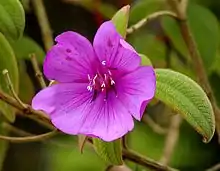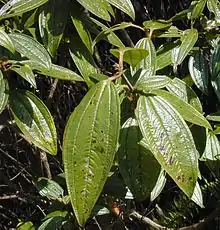Melastomataceae
Melastomataceae (/mɛləstoʊmɑːˈteɪsiˌaɪ, -siːˌiː/) is a family of dicotyledonous flowering plants found mostly in the tropics (two-thirds of the genera are from the New World tropics) comprising c. 175 genera and c. 5115 known species.[3][4] Melastomes are annual or perennial herbs, shrubs, or small trees.
| Melastomataceae Temporal range: | |
|---|---|
 | |
| Pleroma semidecandrum, syn. Tibouchina semidecandra, at Strybing Arboretum, San Francisco | |
| Scientific classification | |
| Kingdom: | Plantae |
| Clade: | Tracheophytes |
| Clade: | Angiosperms |
| Clade: | Eudicots |
| Clade: | Rosids |
| Order: | Myrtales |
| Family: | Melastomataceae Juss.[2] |
| Type genus | |
| Melastoma | |
| Genera | |
|
See text. | |

Description
The leaves of melastomes are somewhat distinctive, being opposite, decussate, and usually with 3-7 longitudinal veins arising either from the base of the blade, plinerved (inner veins diverging above base of blade), or pinnately nerved with three or more pairs of primary veins diverging from the mid-vein at successive points above the base.
Flowers are perfect, and borne either singly or in terminal or axillary, paniculate cymes.
Ecology
A number of melastomes are regarded as invasive species once naturalized in tropical and subtropical environments outside their normal range. Examples are Koster's curse (Clidemia hirta), Pleroma semidecandrum and Miconia calvescens, but many other species are involved.
Taxonomy
Under the APG III system of classification, the seven genera from Memecylaceae are now included in this family.[2]
Genera
There are some 175 accepted genera in the Melastomataceae family as of May 2022. They include:[5]
- Acanthella
- Aciotis
- Acisanthera
- Adelobotrys
- Allomaieta
- Alloneuron
- Amphiblemma
- Amphorocalyx
- Anaectocalyx
- Anaheterotis
- Andesanthus
- Anerincleistus
- Antherotoma
- Appendicularia
- Argyrella
- Arthrostemma
- Aschistanthera
- Astrocalyx
- Astronia
- Astronidium
- Axinaea
- Barthea
- Beccarianthus
- Bellucia
- Bertolonia
- Bisglaziovia
- Blakea
- Blastus
- Boerlagea
- Boyania
- Brachyotum
- Brasilianthus
- Bredia
- Bucquetia
- Cailliella
- Calvoa
- Calycogonium
- Cambessedesia
- Castratella
- Catanthera
- Catocoryne
- Centradenia
- Centradeniastrum
- Centronia
- Chaetogastra
- Chaetolepis
- Chaetostoma
- Chalybea
- Charianthus
- Cincinnobotrys
- Clidemia
- Comolia
- Comoliopsis
- Conostegia
- Creochiton
- Cyphotheca
- Derosiphia
- Desmoscelis
- Dicellandra
- Dichaetanthera
- Dinophora
- Dionycha
- Dionychastrum
- Dissochaeta
- Dissotidendron
- Dissotis
- Driessenia
- Dupineta
- Eriocnema
- Ernestia
- Feliciadamia
- Fordiophyton
- Fritzschia
- Graffenrieda
- Gravesia
- Guyonia
- Henriettea
- Heteroblemma
- Heterocentron
- Heterotis
- Huberia
- Kendrickia
- Kerriothyrsus
- Kirkbridea
- Lavoisiera
- Leandra
- Lijndenia
- Lithobium
- Loricalepis
- Macairea
- Macrocentrum
- Macrolenes
- Maguireanthus
- Maieta
- Mallophyton
- Marcetia
- Mecranium
- Medinilla
- Melastoma
- †Melastomites[6]
- Melastomastrum
- Memecylon
- Meriania
- Merianthera
- Miconia
- Microlicia
- Monochaetum
- Monolena
- Mouriri
- Neblinanthera
- Necramium
- Neodriessenia
- Nepsera
- Nerophila
- Noterophila {Wikispecies)
- Nothodissotis
- Ochthephilus
- Ochthocharis
- Opisthocentra
- Osbeckia
- Ossaea
- Oxyspora
- Pachyanthus
- Pachycentria
- Pachyloma
- Phainantha
- Phyllagathis
- Physeterostemon
- Pilocosta
- Plagiopetalum
- Pleiochiton
- Pleroma
- Plethiandra
- Poikilogyne
- Poilannammia
- Poteranthera
- Preussiella
- Pseudodissochaeta
- Pseudoernestia
- Pternandra
- Pterogastra
- Pterolepis
- Quipuanthus
- Rhexia
- Rhynchanthera
- Rostranthera
- Rousseauxia
- Sagraea
- Salpinga
- Sandemania
- Sarcopyramis
- Schwackaea
- Scorpiothyrsus
- Siphanthera
- Sonerila
- Spathandra
- Sporoxeia
- Stanmarkia
- Stenodon
- Stussenia
- Styrophyton
- Tashiroea
- Tateanthus
- Tessmannianthus
- Tetrazygia
- Tibouchina
- Tigridiopalma
- Tococa
- Trembleya
- Triolena
- Tristemma
- Tryssophyton
- Vietsenia
- Votomita
- Warneckea
- Wurdastom
Foraging
Melastomataceae is foraged by many stingless bees, especially by the species Melipona bicolor which gather pollen from this taxon of flowering plant.[7]
References
- "Myrtales". www.mobot.org. Retrieved 2023-07-20.
- Angiosperm Phylogeny Group (2009), "An update of the Angiosperm Phylogeny Group classification for the orders and families of flowering plants: APG III", Botanical Journal of the Linnean Society, 161 (2): 105–121, doi:10.1111/j.1095-8339.2009.00996.x
- Ulloa Ulloa, Carmen; Almeda, Frank; Goldenberg, Renato; Kadereit, Gudrun; Michelangeli, Fabián A.; Penneys, Darin S.; Stone, R. Douglas; Veranso-Libalah, Marie Claire (2022), Goldenberg, Renato; Michelangeli, Fabián A.; Almeda, Frank (eds.), "Melastomataceae: Global Diversity, Distribution, and Endemism", Systematics, Evolution, and Ecology of Melastomataceae, Cham: Springer International Publishing, pp. 3–28, doi:10.1007/978-3-030-99742-7_1, ISBN 978-3-030-99741-0, retrieved 2023-05-04
- Christenhusz, M. J. M.; Byng, J. W. (2016). "The number of known plants species in the world and its annual increase". Phytotaxa. Magnolia Press. 261 (3): 201–217. doi:10.11646/phytotaxa.261.3.1.
- "Melastomataceae Juss". Plants of the World Online. Royal Botanic Gardens, Kew. Retrieved 4 May 2022.
- LaMotte, R.S. (1952). Catalogue of the Cenozoic plants of North America through 1950. Geological Society of America Memoirs. Vol. 51. Geological Society of America. doi:10.1130/MEM51.
- Hilário, S. D., and V. L. Imperatriz-Fonseca. "Pollen foraging in colonies of Melipona bicolor (Apidae, Meliponini): effects of season, colony size and queen number." Genetics and Molecular Research 8.2 (2009): 664-671.
External links
- PlantSystematics.org: Images of species, list of genera
- Penneys, D. S.; Michelangeli, F. A.; Judd, W. S.; Almeda, F. (1 January 2010). "Henrietteeae (Melastomataceae): A New Neotropical Berry-Fruited Tribe". Systematic Botany. 35 (4): 783–800. doi:10.1600/036364410x539862. JSTOR 40985555. S2CID 85228425.
